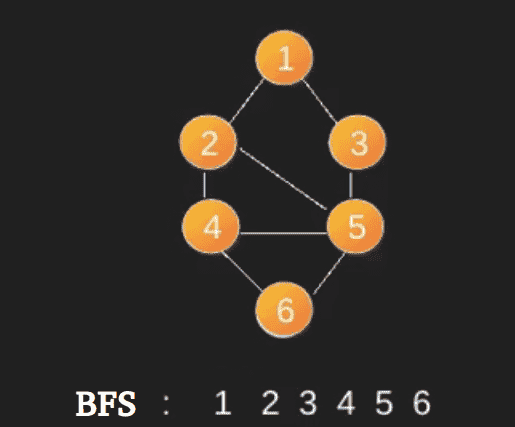基于STL的BFS的简单实现 队列 和 矢量 在STL中。邻接列表使用向量的向量表示。
null
In BFS, we start with a node.
1) Create a queue and enqueue source into it.
Mark source as visited.
2) While queue is not empty, do following
a) Dequeue a vertex from queue. Let this
be f.
b) Print f
c) Enqueue all not yet visited adjacent
of f and mark them visited.
下面是从源顶点1开始的BFS示例。请注意,一个图可能有多个BFS(即使来自特定顶点)。

有关BFS的更多详细信息,请参阅 这篇帖子 . 这里的代码经过简化,可以用于竞争性编码。
CPP
// A Quick implementation of BFS using // vectors and queue #include <bits/stdc++.h> #define pb push_back using namespace std; vector< bool > v; vector<vector< int > > g; void edge( int a, int b) { g[a].pb(b); // for undirected graph add this line // g[b].pb(a); } void bfs( int u) { queue< int > q; q.push(u); v[u] = true ; while (!q.empty()) { int f = q.front(); q.pop(); cout << f << " " ; // Enqueue all adjacent of f and mark them visited for ( auto i = g[f].begin(); i != g[f].end(); i++) { if (!v[*i]) { q.push(*i); v[*i] = true ; } } } } // Driver code int main() { int n, e; cin >> n >> e; v.assign(n, false ); g.assign(n, vector< int >()); int a, b; for ( int i = 0; i < e; i++) { cin >> a >> b; edge(a, b); } for ( int i = 0; i < n; i++) { if (!v[i]) bfs(i); } return 0; } |
Input: 8 10 0 1 0 2 0 3 0 4 1 5 2 5 3 6 4 6 5 7 6 7 Output: 0 1 2 3 4 5 6 7
本文由 尼希尔·马亨德兰 .如果你喜欢GeekSforgek,并想贡献自己的力量,你也可以使用 写极客。组织 或者把你的文章寄去评论-team@geeksforgeeks.org.看到你的文章出现在Geeksforgeks主页上,并帮助其他极客。 如果您发现任何不正确的地方,或者您想分享有关上述主题的更多信息,请写下评论。
© 版权声明
文章版权归作者所有,未经允许请勿转载。
THE END


![关于”PostgreSQL错误:关系[表]不存在“问题的原因和解决方案-yiteyi-C++库](https://www.yiteyi.com/wp-content/themes/zibll/img/thumbnail.svg)



